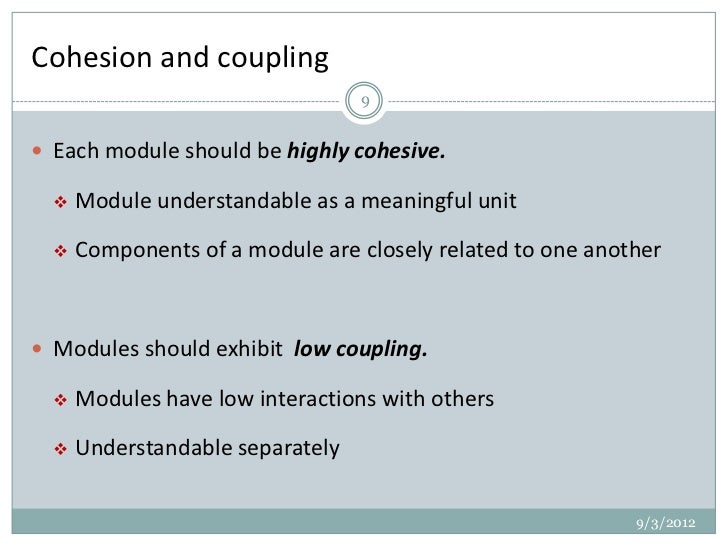

For example, a module containing all the functions required to manage employees’ pay-roll exhibits functional cohesion.
Functional Cohesion: Functional cohesion is said to exist if different elements of a module cooperate to achieve a single function. For example, in a TPS, the get-input, validate-input, sort-input functions are grouped into one module. Thus, it is important to also measure the coupling and cohesion of the. Sequential Cohesion: A module is said to possess sequential cohesion if the elements of a module form the parts of the sequence, where the output from one element of the sequence is input to the next. The software engineering discipline has established some common measures of. the set of functions defined on an array or a stack. #Coupling and cohesion in software engineering ppt update
Communicational Cohesion: A module is said to have communicational cohesion, if all functions of the module refer to or update the same data structure, e.g.This is, more or less, the classic software development model. Under the best circumstances, one goes from an idea to requirements, design, coding, testing, deployment, and then a maintenance phase. Procedural Cohesion: A module is said to possess procedural cohesion, if the set of functions of the module are all part of a procedure (algorithm) in which certain sequence of steps have to be carried out for achieving an objective, e.g. Coupling and Cohesion: A View of Software Design from the Inside Out Software development is time-consuming and expensive.The set of functions responsible for initialization, start-up, a shutdown of some process, etc. Temporal Cohesion: When a module contains functions that are related by the fact that all the functions must be executed in the same time span, the module is said to exhibit temporal cohesion.An example of logical cohesion is the case where a set of print functions generating different output reports are arranged into a single module. error handling, data input, data output, etc. Logical Cohesion: A module is said to be logically cohesive, if all elements of the module perform similar operations, e.g.The grouping does not have any relevance to the structure of the problem. For example, in a transaction processing system (TPS), the get-input, print-error, and summarize members functions are grouped into one module. It is likely that the functions have been put in the module out of pure coincidence without any design or thought. In this case, the module contains a random collection of functions.

 Coincidental Cohesion: A module is said to have coincidental cohesion if it performs a set of function or tasks that relate to each other very loosely. This case will consume more effort since we will need to put more time into investigating and correcting the defect.The different classes of cohesion that a module may possess are shown in Fig. That’s because a class can be reported as defective, while in reality, the defect resides in one of its dependencies. In case we avoid mocks, high coupling increases the number of side effects. If we use mocks, having many collaborators heavily increases the effort to mock them. Testing a class with many collaborators often requires considerable setup and/or side effects. Version-classing is a high coupling symptom. Coupling refers to the interdependencies between modules, while cohesion describes how related the functions within a single module are. We have all felt the pain of being unable to make use of two third-party libraries simply because they depend on a different version of another library. Those are called transitive dependencies. Importing a module that depends on several other modules and third-party libraries makes you depend on all those as well. High coupling minimizes opportunities for reuse. As Uncle Bob says: “This system exhibits the symptom of fragility.” All its clients now need to change in order to compile. Imagine several classes depending on a single function that has to change its signature. ra/n Quality of software design also plays an important role in determining the overall quality of the software.
Coincidental Cohesion: A module is said to have coincidental cohesion if it performs a set of function or tasks that relate to each other very loosely. This case will consume more effort since we will need to put more time into investigating and correcting the defect.The different classes of cohesion that a module may possess are shown in Fig. That’s because a class can be reported as defective, while in reality, the defect resides in one of its dependencies. In case we avoid mocks, high coupling increases the number of side effects. If we use mocks, having many collaborators heavily increases the effort to mock them. Testing a class with many collaborators often requires considerable setup and/or side effects. Version-classing is a high coupling symptom. Coupling refers to the interdependencies between modules, while cohesion describes how related the functions within a single module are. We have all felt the pain of being unable to make use of two third-party libraries simply because they depend on a different version of another library. Those are called transitive dependencies. Importing a module that depends on several other modules and third-party libraries makes you depend on all those as well. High coupling minimizes opportunities for reuse. As Uncle Bob says: “This system exhibits the symptom of fragility.” All its clients now need to change in order to compile. Imagine several classes depending on a single function that has to change its signature. ra/n Quality of software design also plays an important role in determining the overall quality of the software. 
This ratio also measures the connectivity density of the architecture and is calculated by the following equation. A change in one portion of the system can break the behavior in another, distant part of the system. Coupling of the architecture is indicated by arc-to-node ratio.








 0 kommentar(er)
0 kommentar(er)
